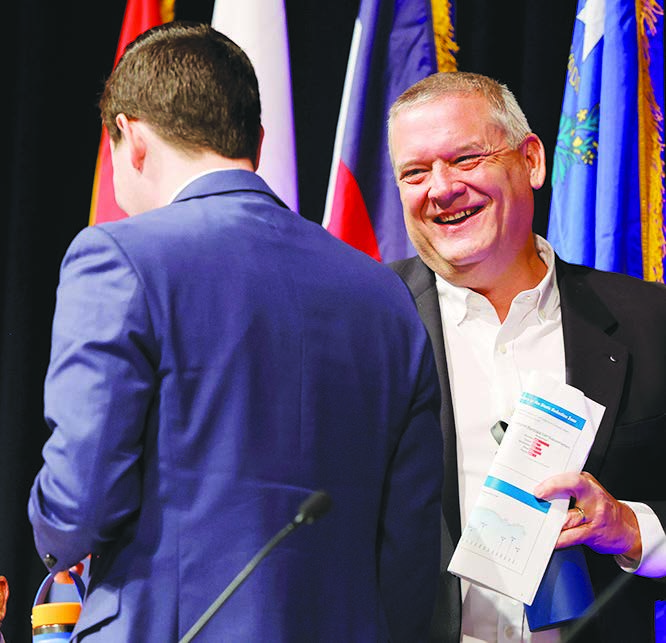
STEVE MARCUS
Before the Colorado River Water Users Association conference started Wednesday in Las Vegas, some attendees trekked out to Boulder City for a tour of Hoover Dam. There, the 44 water leaders in attendance saw what many locals have witnessed through the years: declining water levels at Lake Mead. It was a stark reminder of why they were in Southern Nevada: to discuss a new deal between the seven Colorado River Basin states, tribes and Mexico that depend on the Colorado for their water. Legal agreements appropriating water from the drought-stricken river expire in 2026.
Lake Mead’s “bathtub ring,” produced from mineral compounds leaving behind white marks on the lake’s shoreline as water levels have receded, is front and center. Attendees of the conference saw the 140-foot tall ring from a cliff view at Lake Mead.
“It’s the one precious resource that we can never duplicate,” said Celeste Arellano, a member of the Pueblo Water Board in Colorado, who attended the tour. “We can always make energy. We can’t produce water.”
The tour is the annual kickoff of the conference to show the critical infrastructure that makes up part of the Colorado River. Sessions at this year’s conference, themed “Piecing the Puzzles Together,” were designed to help fit together the various competing interests among Colorado River water users, including tribal, municipal, agricultural, conservation and environmental concerns, said Gene Shawcroft, president of the Colorado River Water Users Association.
Climate change and explosive growth in the region have introduced new variability and instability that was not affecting the river when the 1922 Colorado River Compact was signed and require discussions to craft a solution.
“This conference historically has been pretty cooperative, pretty positive but (there’s) real deadlines approaching,” said John Entsminger, general manager of the Southern Nevada Water Authority. “There’s a little bit more friction right now.”
Water stakeholders across the basin have a responsibility to solve the puzzle for the people of the American West, Shawcroft said. There is also a responsibility to manage the river in an efficient way to ensure its future.
“Like a real puzzle, we can see the picture of what it is supposed to look like on the box, but fitting it together is another challenge,” Shawcroft said. The 1922 Colorado River Compact is still enforced, but the operating guidelines are being negotiated, said Jennifer Pitt, the Colorado River program director at the National Audubon Society.
The long-term guidelines, referred to as Post-2026 Operations, will revisit the 2007 Interim Guidelines and other operating agreements that expire in 2026, including drought contingency plans and Minute 323, which allows Mexico to continue to store water in Lake Mead, according to the association’s 2023 report.
Lower Basin states — Nevada, California and Arizona — agreed in August to reductions of 3 million acre-feet from their Colorado River water allocations, Mack said. Nevada is on track to make its contributions to those reductions.
The state has been able to reduce 40% of water use even as it experienced an increase of more than 840,000 new residents. “We’ve been making this adaptation in water conservation over the past two decades,” Mack said, “which really does have us in a lead position when it comes to water conservation.”
But managing the Colorado River is more than determining water allocations for the states and how to manage flows at Lake Mead and Lake Powell.
In the Bipartisan Infrastructure Act and federal agencies, more than $2 billion is set aside annually to build resiliency along the Colorado River, said Fay Hartman, the conservation director of the southwest region of American Rivers. The funding, in part, helps with programs to improve forest management and assist agricultural stakeholders to adapt to a changing climate, community and industrial conservation.
“All of those pieces are really important in helping to improve the resilience of the system as a whole,” Hartman said. “When we have a healthy river system that’s resilient, we can weather the storm and the uncertainties of climate.” With a new administration taking over the federal government in January, attendees expressed concern that funding could be pulled back.
“This is usually a bipartisan issue,” said Taylor Hawes, the director of the Colorado River Program at the Nature Conservancy. “So we’re hopeful that many of the legislators will continue to be a champion for those funds to come to the basin.”
ilana.williams@gmgvegas. com / 702-948-7836 / @ilana_willi

